Influence of Framework Material and Abutment Configuration on Fatigue Performance in Dental Implant Systems: A Finite Element Analysis
Abstract
:1. Introduction
2. Materials and Methods
2.1. Preparation of Specimens
2.2. Estimating the Stress Distribution
2.3. Estimating the Fatigue Performance
3. Results
3.1. Stress Distribution
3.1.1. Stress Values on the Implant
3.1.2. Stress Values on the Abutment
3.1.3. Stress Values on the Cortical Bone
3.1.4. Stress Values on the Framework
3.1.5. Stress Values on the Abutment Screw
3.1.6. Stress Values on the Occlusal Screw
3.1.7. Stress Values on the Resin Cement
3.2. Fatigue Performance
3.2.1. Fatigue Performance of Implant
3.2.2. Fatigue Performance of Abutment
3.2.3. Fatigue Performance of Abutment Screw
3.2.4. Fatigue Performance of Occlusal Screw
4. Discussion
5. Conclusions
- In general, and especially in the case of implant restorations with an increased angle, the choice of multi-unit restorations will greatly increase the survival rate;
- PFBZ does not offer an ideal treatment alternative for implant restorations. Implant restorations with PFBM are currently still a better alternative;
- Occlusal screws are the most durable components when each stage is performed perfectly, in accordance with the procedure;
- Considering the chewing force on the molar region, posterior implant planning should be performed precisely;
- The placement of implants with a straight angle should be considered among the basic steps for the success of prosthetic treatments and surgical procedures should be carried out with sensitivity in this regard.
Author Contributions
Funding
Institutional Review Board Statement
Informed Consent Statement
Data Availability Statement
Acknowledgments
Conflicts of Interest
References
- Mosharraf, R.; Abbasi, M.; Givehchian, P. The Effect of Abutment Angulation and Crown Material Compositions on Stress Distribution in 3-Unit Fixed Implant-Supported Prostheses: A Finite Element Analysis. Int. J. Dent. 2022, 2022, 4451810. [Google Scholar] [CrossRef]
- de Souza Pereira, P.H.; Amaral, M.; Baroudi, K.; Vitti, R.P.; Nassani, M.Z.; Silva-Concílio, L.R. Effect of Implant Platform Connection and Abutment Material on Removal Torque and Implant Hexagon Plastic Deformation. Eur. J. Dent. 2019, 13, 349–353. [Google Scholar] [CrossRef]
- Pesce, P.; Fabbro, M.D.; Menini, M.; Giovanni, E.D.; Annunziata, M.; Khijmatgar, S.; Canullo, L. Effects of Abutment Materials on Peri-Implant Soft Tissue Health and Stability: A Network Meta-Analysis. J. Prosthodont. Res. 2023, 67, 506–517. [Google Scholar] [CrossRef] [PubMed]
- Yao, K.-T.; Chang, T.-Y.; Huang, G.-J.; Fang, H.-W.; Wang, D.-H.; Hsu, M.-L. Survival of Four Conical Implant Abutment Connections After Removal of the Abutment Screw and Simulated Cyclic Loading: An In Vitro Comparative Study. J. Oral Implantol. 2023, 49, 393–400. [Google Scholar] [CrossRef]
- Tao, B.; Feng, Y.; Fan, X.; Lan, K.; Zhuang, M.; Wang, S.; Wang, F.; Chen, X.; Wu, Y. The Accuracy of a Novel Image-guided Hybrid Robotic System for Dental Implant Placement: An in Vitro Study. Int. J. Med. Robot. Comput. Assist. Surg. 2022, 19, e2452. [Google Scholar] [CrossRef] [PubMed]
- Badalia, I.; Kumar, M.; Bansal, A.; Mehra, S.K.; Batra, R. Evaluation of Stress Patterns in Bone Around Implants for Different Abutment Angulations under Axial and Oblique Loading in Anterior Maxillary Region—A Finite Element Analysis. Dent. J. Adv. Stud. 2020, 8, 60–64. [Google Scholar] [CrossRef]
- Hassan, S.S.M.; Emarah, A. All on 4 Versus All on 6 Implant Concepts for Rehabilitation of Edentulous Maxilla. Short Term Randomized Clinical and Radiographic Study. Egypt. Dent. J. 2020, 66, 659–670. [Google Scholar] [CrossRef]
- Nag, P.V.R.; Ramanathan, M.; Puppala, S.; Daniel, S.; Vasundhara, K.A. Rehabilitation of Atrophic Posterior Partial Edentulous Maxilla with TTPHIL ALL TILT® Technique: 3 Year Follow-Up Case Report. Braz. Dent. Sci. 2022, 25, e3315. [Google Scholar] [CrossRef]
- Wu, A.Y.; Hsu, J.-T.; Fuh, L.; Huang, H. Effects of Positions and Angulations of Titanium Dental Implants in Biomechanical Performances in the All-on-Four Treatment: 3D Numerical and Strain Gauge Methods. Metals 2020, 10, 280. [Google Scholar] [CrossRef]
- Khairallah, A.; Hamed, M. Biological and Prosthetic Complications of Cantilevered and Non-Cantilevered Fixed Hybrid Metal Acrylic Prostheses Used for Vertical and Inclined Implants in Atrophied Mandible. A Randomized Clinical Trial. Egypt. Dent. J. 2021, 67, 717–728. [Google Scholar] [CrossRef]
- Scotton, R.; Claudino, D.D.; Savaris, L.B.; Mendes, F.M.F.; de Oliveira Stroparo, J.L.; Storrer, C.L.M.; Rezende, C.E.E.; Macedo, R.M.; Gabardo, M.C.L.; Zielak, J.C. Stress Distribution around Short Implants with Different Frictional Joint Designs: A Photoelastic Colorimetric Analysis/Distribuição De Tensão Em Torno De Implantes Curtos Com Diferentes Designs De Fricção: Uma Análise Colorimétrica. Brazilian J. Dev. 2021, 7, 106244–106255. [Google Scholar] [CrossRef]
- Rostom, D.A.; Ragheb, N. Retention and Wear Characteristic Assessment of OT Equator with Smart Box Attachment Versus Ball Attachment for Mandibular Two Implant Assisted Over Denture. In-Vitro Study. Egypt. Dent. J. 2021, 67, 3525–3532. [Google Scholar] [CrossRef]
- Kitagawa, T.; Tanimoto, Y.; Murakami, H.; Igeta, S.; Tamaki, H.; Komiyama, O.; Kato, T. Evaluating the Dynamic Behavior of Taper Joint Implants under Different Loading Conditions:A Transient Dynamic Finite Element Analysis. Int. J. Oral-Med. Sci. 2013, 12, 105–111. [Google Scholar] [CrossRef]
- Hamza, G.E.; El-Zawahry, M.M.; ElGbary, H.S.; El-Anwar, M.I. Angulated Dental Implant Versus Vertical One Finite Element Study. J. Int. Soc. Sci. Eng. 2021, 3, 18–24. [Google Scholar] [CrossRef]
- Özdoğan, M.; Gokce, H.; Şahin, İ. Effect of Straight and Angled Abutments on the Strain on a Zirconia Crown and Implant in the Mandibular Second Molar Region: A Fea-Based Study. Mater. Tehnol. 2020, 54, 251–257. [Google Scholar] [CrossRef]
- Anitua, E.; Fernández-de-Retana, S.; Alkhraisat, M.H. Survival and Marginal Bone Loss of Dental Implants Supporting Cad-Cam Angled Channel Restorations: A Split-Mouth Retrospective Study. Eur. J. Dent. 2020, 14, 194–199. [Google Scholar] [CrossRef]
- Frantz, K.; Funkenbusch, P.; Feng, C.; Tsigarida, A.; Chochlidakis, K.; Lo Russo, L.; Ercoli, C. Effect of Implant Angulation and Patrice on the Retention of Overdenture Attachment Systems: An in Vitro Study. J. Prosthodont. 2023, 33, 452–459. [Google Scholar] [CrossRef]
- Wadia, R. Abutment Material and Peri-Implant Soft Tissue. Br. Dent. J. 2020, 228, 82. [Google Scholar] [CrossRef]
- Laleman, I.; Lambert, F. Implant Connection and Abutment Selection as a Predisposing and/or Precipitating Factor for Peri-Implant Diseases: A Review. Clin. Implant Dent. Relat. Res. 2023, 25, 723–733. [Google Scholar] [CrossRef]
- Laleman, I.; Lambert, F.; Gahlert, M.; Bacevic, M.; Woelfler, H.; Roehling, S. The Effect of Different Abutment Materials on Peri-Implant Tissues—A Systematic Review and Meta-Analysis. Clin. Oral Implants Res. 2023, 34 (Suppl. S26), 125–142. [Google Scholar] [CrossRef]
- Dayan, S.C.; Geckili, O. The Influence of Framework Material on Stress Distribution in Maxillary Complete-Arch Fixed Prostheses Supported by Four Dental Implants: A Three-Dimensional Finite Element Analysis. Comput. Methods Biomech. Biomed. Engin. 2021, 24, 1606–1617. [Google Scholar] [CrossRef]
- Rismanchian, M.; Davoudi, A.; Nosouhian, S.; Tabesh, M.; Rismanchian, M. Internal and Marginal Fit Accuracy of Pre-Sintered CAD/CAM Implant-Supported Frameworks before and after Porcelain Layering. Int. J. Oral Maxillofac. Implants 2022, 37, 601–607. [Google Scholar] [CrossRef] [PubMed]
- Aboelfadl, A.; Taha, M.M. Effect of Implant Abutment Venting on Peri-Implant Soft Tissue Response. A Randomized Clinical Trial. Egypt. Dent. J. 2018, 64, 1813–1824. [Google Scholar] [CrossRef]
- Alsubaiy, E.F. Abutment Screw Loosening in Implants: A Literature Review. J. Fam. Med. Prim. Care 2020, 9, 5490–5494. [Google Scholar] [CrossRef]
- Londhe, S.M.; Gowda, E.M.; Mandlik, V.B.; Shashidhar, M.P. Factors Associated with Abutment Screw Loosening in Single Implant Supported Crowns: A Cross-Sectional Study. Med. J. Armed Forces India 2020, 76, 37–40. [Google Scholar] [CrossRef]
- Amini, P. Evaluation of the Effect of Surface Roughness and Modification of Implant Abutment Axial Wall on the Retention of Zirconium Oxide Copings before and after Thermocycling. J. Clin. Exp. Dent. 2024, 16, e399–e405. [Google Scholar] [CrossRef]
- Kim, H.J.; Karasan, D.; Park, K.; Kwon, H.-B.; Han, J.; Lee, J. Abutment Margin Levels and Residual Cement Occurrence in Cement-retained Implant Restorations: An Observational Study. Clin. Oral Implants Res. 2022, 34, 33–41. [Google Scholar] [CrossRef] [PubMed]
- Gönder, A.; Polat, S.; Kılıçarslan, M.A.; Ocak, M.; Tamam, E. How Can Excess Residual Cement Be Reduced in Implant-Supported Restorations?: An in Vitro Study. Clin. Implant Dent. Relat. Res. 2023, 25, 807–814. [Google Scholar] [CrossRef]
- Çeken, A. Effect of Abutment Types and Resin Cements on the Esthetics of Implant-Supported Restorations. J. Adv. Prosthodont. 2023, 15, 114. [Google Scholar] [CrossRef]
- Salama, A.; Radwan, M.M.; Bushra, S. Influence of Thermo-Mechanical Aging on Straight Versus Angled Multi-Unit Abutments Screw Joint Stability. Egypt. Dent. J. 2023, 69, 487–495. [Google Scholar] [CrossRef]
- Güven, M.E. Effect of Dynamic Cycles and Abutment Angle on the Screw Stability of Standard and Narrow Implants: An in Vitro Study. Med. Sci. Discov. 2023, 10, 911–917. [Google Scholar] [CrossRef]
- Müller, L.; Rauch, A.; Reissmann, D.R.; Schierz, O. Impact of Cement Type and Abutment Height on Pull-Off Force of Zirconia Reinforced Lithium Silicate Crowns on Titanium Implant Stock Abutments: An in Vitro Study. BMC Oral Health 2021, 21, 592. [Google Scholar] [CrossRef] [PubMed]
- Hamed, M.T.; Mously, H.A.; Alamoudi, S.K.; Hashem, A.B.H.; Naguib, G.H. A Systematic Review of Screw Versus Cement-Retained Fixed Implant Supported Reconstructions. Clin. Cosmet. Investig. Dent. 2020, 12, 9–16. [Google Scholar] [CrossRef]
- Kanneganti, K.C.; Vinnakota, D.N.; Pottem, S.R.; Pulagam, M. Comparative Effect of Implant-Abutment Connections, Abutment Angulations, and Screw Lengths on Preloaded Abutment Screw Using Three-Dimensional Finite Element Analysis: An in Vitro Study. J. Indian Prosthodont. Soc. 2018, 18, 161. [Google Scholar] [CrossRef]
- Kan, J.Y.K.; Rungcharassaeng, K.; Kamolroongwarakul, P.; Lin, G.; Matsuda, H.; Yin, S.; Wang, H.; Tarnow, D.P.; Lozada, J. Frequency of Screw-retained Angulated Screw Channel Single Crown Following Immediate Implant Placement and Provisionalization in the Esthetic Zone: A Cone Beam Computed Tomography Study. Clin. Implant Dent. Relat. Res. 2023, 25, 789–794. [Google Scholar] [CrossRef] [PubMed]
- Emam, M.; Arafa, M.A. Stress Distribution and Fracture Resistance of Green Reprocessed Polyetheretherketone (PEEK) Single Implant Crown Restorations Compared to Unreprocessed PEEK and Zirconia: An in-Vitro Study. BMC Oral Health 2023, 23, 275. [Google Scholar] [CrossRef] [PubMed]
- Fayyad, A. Comparison Between Two Different Unilateral Mandibular Partial Denture Designs Retained by Extra-Coronal Attachment. An In-Vitro Study. Egypt. Dent. J. 2022, 68, 2479–2485. [Google Scholar] [CrossRef]
- Barragán-Paredes, M.A.; Mosquera-Victoria, I.; Viveros-Rebolledo, C.A.; Rodríguez-Paz, M.L.; Muñoz-Vélez, M.F.; Llano, C.H.V. Comparison of the Mechanical Properties of Temporary Abutments Made of Polyetheretherketone and Photopolymeric Resin. Open Dent. J. 2021, 15, 512–519. [Google Scholar] [CrossRef]
- Yilmaz, B.; Alsaery, A.; Altintas, S.H.; Schimmel, M. Comparison of Strains for New Generation CAD-CAM Implant-supported Crowns under Loading. Clin. Implant Dent. Relat. Res. 2020, 22, 397–402. [Google Scholar] [CrossRef]
- Takata, H.; Komine, F.; Honda, J.; Blatz, M.B.; Matsumura, H. An in Vitro Evaluation of Fracture Load of Implant-supported Zirconia-based Prostheses Fabricated with Different Veneer Materials. Clin. Oral Implants Res. 2018, 29, 396–403. [Google Scholar] [CrossRef]
- Zhang, X.; Mao, J.; Zhou, Y.; Ji, F.; Chen, X. Mechanical Properties and Osteoblast Proliferation of Complex Porous Dental Implants Filled with Magnesium Alloy Based on 3D Printing. J. Biomater. Appl. 2020, 35, 1275–1283. [Google Scholar] [CrossRef] [PubMed]
- Poovarodom, P.; Rungsiyakull, C.; Suriyawanakul, J.; Li, Q.; Sasaki, K.; Yoda, N.; Rungsiyakull, P. Effect of Implant Placement Depth on Bone Remodeling on Implant-Supported Single Zirconia Abutment Crown: A 3D Finite Element Study. J. Prosthodont. Res. 2023, 67, 278–287. [Google Scholar] [CrossRef] [PubMed]
- Sevimay, M.; Üşümez, A.; Eskitaşçıoğlu, G. The Influence of Various Occlusal Materials on Stresses Transferred to Implant-supported Prostheses and Supporting Bone: A Three-dimensional Finite-element Study. J. Biomed. Mater. Res. Part B Appl. Biomater. 2005, 73, 140–147. [Google Scholar] [CrossRef] [PubMed]
- Bakitian, F.; Papia, E.; Larsson, C.; von Steyern, P.V. Evaluation of Stress Distribution in Tooth-Supported Fixed Dental Prostheses Made of Translucent Zirconia with Variations in Framework Designs: A Three-Dimensional Finite Element Analysis. J. Prosthodont. 2020, 29, 315–322. [Google Scholar] [CrossRef] [PubMed]
- Agustín-Panadero, R.; Román-Rodríguez, J.-L.; Ferreiroa, A.; Solá-Ruíz, M.F.; Fons-Font, A. Zirconia in Fixed Prosthesis. A Literature Review. J. Clin. Exp. Dent. 2014, 6, e66–e73. [Google Scholar] [CrossRef]
- Alqahtani, A.R.; Desai, S.R.; Patel, J.R.; Alqhtani, N.R.; Alqahtani, A.S.; Heboyan, A.; Fernandes, G.V.O.; Mustafa, M.; Karobari, M.I. Investigating the Impact of Diameters and Thread Designs on the Biomechanics of Short Implants Placed in D4 Bone: A 3D Finite Element Analysis. BMC Oral Health 2023, 23, 686. [Google Scholar] [CrossRef]
- Al-Kordy, N.M.T.A.; Al-Saadi, M.H. Finite Element Study of Stress Distribution with Tooth-Supported Mandibular Overdenture Retained by Ball Attachments or Resilient Telescopic Crowns. Eur. J. Dent. 2023, 17, 539–547. [Google Scholar] [CrossRef]
- Mozaffari, A.; Hashtbaran, D.; Moghadam, A.; Aalaei, S. Stress Distribution in Peri-Implant Bone in the Replacement of Molars with One or Two Implants: A Finite Element Analysis. J. Dent. 2023, 24, 132. [Google Scholar]
- Ersöz, M.B.T.; Mumcu, E. Biomechanical Investigation of Maxillary Implant-Supported Full-Arch Prostheses Produced with Different Framework Materials: A Finite Elements Study. J. Adv. Prosthodont. 2022, 14, 346. [Google Scholar] [CrossRef]
- Chen, S.; Hong, X.; Ye, Z.; Wu, M.; Chen, L.; Wu, L.; Wang, Y.; Chen, Y.; Wu, J.; Wang, J. The Effect of Root Canal Treatment and Post-Crown Restorations on Stress Distribution in Teeth with Periapical Periodontitis: A Finite Element Analysis. BMC Oral Health 2023, 23, 973. [Google Scholar] [CrossRef]
- Brown, M.W.; Miller, K.J. A Theory for Fatigue Failure under Multiaxial Stress-Strain Conditions. Proc. Inst. Mech. Eng. 1973, 187, 745–755. [Google Scholar] [CrossRef]
- Duan, Y.; Gonzalez, J.A.; Kulkarni, P.A.; Nagy, W.W.; Griggs, J.A. Fatigue Lifetime Prediction of a Reduced-Diameter Dental Implant System: Numerical and Experimental Study. Dent. Mater. 2018, 34, 1299–1309. [Google Scholar] [CrossRef]
- Young, C.S.; Durham, J.C. Industrial Applications of Titanium and Zirconium: Fourth Volume: A Symposium; ASTM International: West Conshohocken, PA, USA, 1986; Volume 4, ISBN 0803104847. [Google Scholar]
- Allum, S.R.; Tomlinson, R.A.; Joshi, R. The Impact of Loads on Standard Diameter, Small Diameter and Mini Implants: A Comparative Laboratory Study. Clin. Oral Implants Res. 2008, 19, 553–559. [Google Scholar] [CrossRef] [PubMed]
- Fuentes, R.; Arias, A.; Lezcano, M.F.; Saravia, D.; Kuramochi, G.; Navarro, P.; Días, F.J. A New Tridimensional Insight into Geometric and Kinematic Characteristics of Masticatory Cycles in Participants with Normal Occlusion. Biomed Res. Int. 2018, 2018, 2527463. [Google Scholar] [CrossRef] [PubMed]
- van Casteren, A.; Codd, J.R.; Kupczik, K.; Plasqui, G.; Sellers, W.I.; Henry, A.G. The Cost of Chewing: The Energetics and Evolutionary Significance of Mastication in Humans. Sci. Adv. 2024, 8, eabn8351. [Google Scholar] [CrossRef] [PubMed]
- Lovera-Prado, K.; Vanaclocha, V.; Atienza, C.M.; Vanaclocha, A.; Jordá-Gómez, P.; Saiz-Sapena, N.; Vanaclocha, L. Barbed Dental Ti6Al4V Alloy Screw: Design and Bench Testing. Materials 2023, 16, 2228. [Google Scholar] [CrossRef]
- Lee, W.-T.; Koak, J.; Lim, Y.; Kim, S.-K.; Kwon, H.-B.; Kim, M. Stress Shielding and Fatigue Limits of Poly-ether-ether-ketone Dental Implants. J. Biomed. Mater. Res. Part B Appl. Biomater. 2012, 100, 1044–1052. [Google Scholar] [CrossRef]
- López-Píriz, R.; Cabal, B.; Goyos-Ball, L.; Fernández, A.; Bartolomé, J.F.; Moya, J.S.; Torrecillas, R. Current State-of-the-art and Future Perspectives of the Three Main Modern Implant-dentistry Concerns: Aesthetic Requirements, Mechanical Properties, and Peri-implantitis Prevention. J. Biomed. Mater. Res. Part A 2019, 107, 1466–1475. [Google Scholar] [CrossRef]
- Lauritano, D.; Moreo, G.; Lucchese, A.; Viganoni, C.; Limongelli, L. The Impact of Implant–Abutment Connection on Clinical Outcomes and Microbial Colonization: A Narrative Review. Materials 2020, 13, 1131. [Google Scholar] [CrossRef]
- Cho, W.-R.; Huh, Y.; Park, C.-J.; Cho, L. Effect of Cyclic Loading and Retightening on Reverse Torque Value in External and Internal Implants. J. Adv. Prosthodont. 2015, 7, 288–293. [Google Scholar] [CrossRef]
- Abasolo, M.; Aguirrebeitia, J.; Vallejo, J.; Albizuri, J.; Coria, I. Influence of Vertical Misfit in Screw Fatigue Behavior in Dental Implants: A Three-Dimensional Finite Element Approach. Proc. Inst. Mech. Eng. Part H J. Eng. Med. 2018, 232, 1117–1128. [Google Scholar] [CrossRef] [PubMed]
- Arshad, M.; Shirani, G.; Refoua, S.; Yeganeh, M.R. Comparative Study of Abutment Screw Loosening with or without Adhesive Material. J. Adv. Prosthodont. 2017, 9, 99–103. [Google Scholar] [CrossRef]
- Choi, J.-W.; Lee, J.-J.; Bae, E.; Huh, J.-B. Implant-Supported Fixed Dental Prosthesis with a Microlocking Implant Prosthetic System: A Clinical Report. J. Prosthet. Dent. 2020, 123, 15–19. [Google Scholar] [CrossRef] [PubMed]
- de Campos, M.R.; Botelho, A.L.; dos Reis, A.C. Reasons for the Fatigue of Ball Attachments and Their O-Rings: A Systematic Review. Dent. Med. Probl. 2023, 60, 167–176. [Google Scholar] [CrossRef]
- Sun, F.; Lv, L.-T.; Cheng, W.; Zhang, J.-L.; Ba, D.; Song, G.; Lin, Z. Effect of Loading Angles and Implant Lengths on the Static and Fatigue Fractures of Dental Implants. Materials 2021, 14, 5542. [Google Scholar] [CrossRef] [PubMed]
- Atalay, P.; Öztaş, D.D. Fatigue Resistance and Fracture Strength of Narrow-diameter One-piece Zirconia Implants with Angled Abutments. J. Esthet. Restor. Dent. 2022, 34, 1060–1067. [Google Scholar] [CrossRef]
- Suzuki, H.; Hata, Y.; Watanabe, F. Implant Fracture under Dynamic Fatigue Loading: Influence of Embedded Angle and Depth of Implant. Odontology 2015, 104, 357–362. [Google Scholar] [CrossRef]
- Demet, S.M.; Ersoyoğlu, A.S. An Analysis of the Effect of Pressure Angle Change on Bending Fatigue Performance in Asymmetrical Spur Gears. Proc. Inst. Mech. Eng. Part L J. Mater. Des. Appl. 2021, 235, 2142–2150. [Google Scholar] [CrossRef]
- Kaweewongprasert, P.; Phasuk, K.; Levon, J.A.; Eckert, G.J.; Feitosa, S.; Valandro, L.F.; Bottino, M.C.; Morton, D. Fatigue Failure Load of Lithium Disilicate Restorations Cemented on a Chairside Titanium-Base. J. Prosthodont. 2018, 28, 973–981. [Google Scholar] [CrossRef]
- Pucci, C.R.; Mafetano, A.P.V.P.; Borges, A.L.S.; de Andrade, G.S.; Dal Piva, A.M.D.O.; Kleverlaan, C.J.; Tribst, J.P.M. Substrate Rigidity Effect on CAD/CAM Restorations at Different Thicknesses. Eur. J. Dent. 2022, 17, 1020–1028. [Google Scholar] [CrossRef]
- Jung, R.E.; Pjetursson, B.E.; Glauser, R.; Zembic, A.; Zwahlen, M.; Lang, N.P. A Systematic Review of the 5-year Survival and Complication Rates of Implant-supported Single Crowns. Clin. Oral Implants Res. 2007, 19, 119–130. [Google Scholar] [CrossRef] [PubMed]
- Sailer, I.; Strasding, M.; Valente, N.A.; Zwahlen, M.; Liu, S.; Pjetursson, B.E. A Systematic Review of the Survival and Complication Rates of Zirconia-Ceramic and Metal-Ceramic Multiple-Unit Fixed Dental Prostheses. Clin. Oral Implants Res. 2018, 29 (Suppl. S1), 184–198. [Google Scholar] [CrossRef] [PubMed]
- Hosseini, M.; Worsaae, N.; Gotfredsen, K. A 5-year Randomized Controlled Trial Comparing Zirconia-based Versus Metal-based Implant-supported Single-tooth Restorations in the Premolar Region. Clin. Oral Implants Res. 2022, 33, 792–803. [Google Scholar] [CrossRef] [PubMed]
- Bajunaid, S.O.; Alshiddi, I.F.; Alhomaidhi, L.; Almutairi, R.; Alolayan, S.; Habib, S.R. Comparison of the Fracture Resistance and Fracture Mode of Contemporary Restorative Materials to Overcome the Offset of Mandibular Implant-Supported, Cement-Retained Crowns. Materials 2021, 14, 4838. [Google Scholar] [CrossRef]

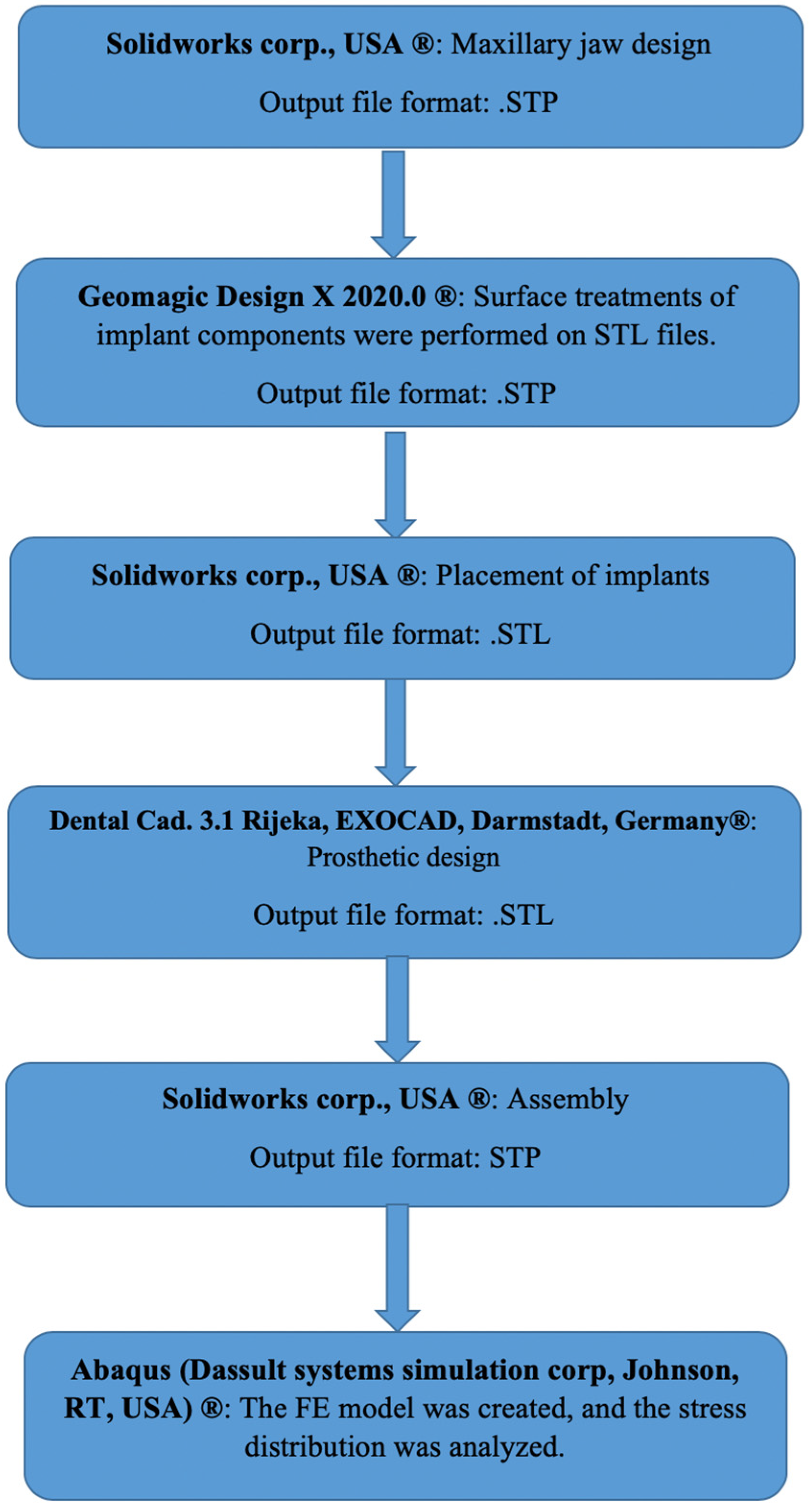
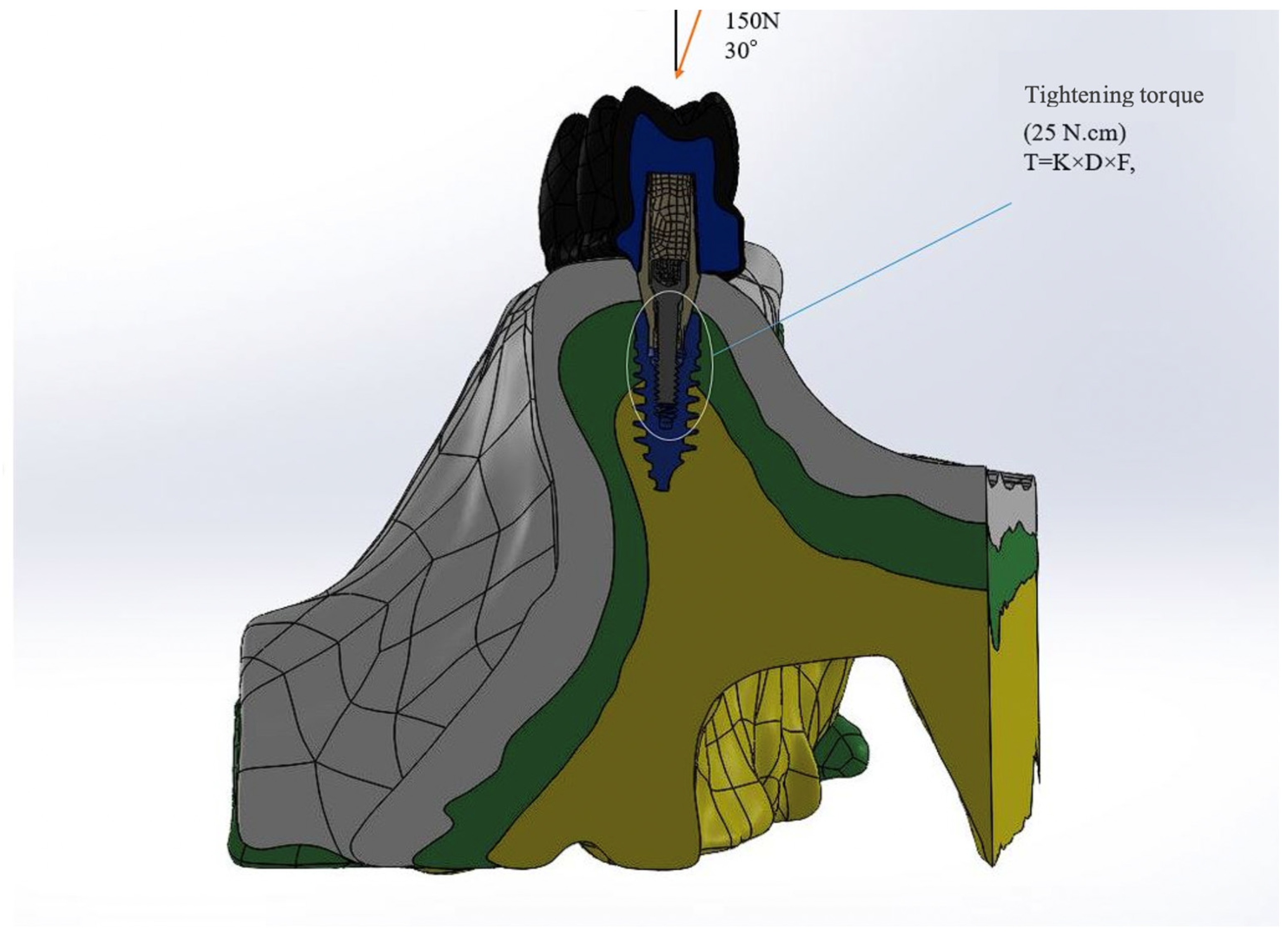
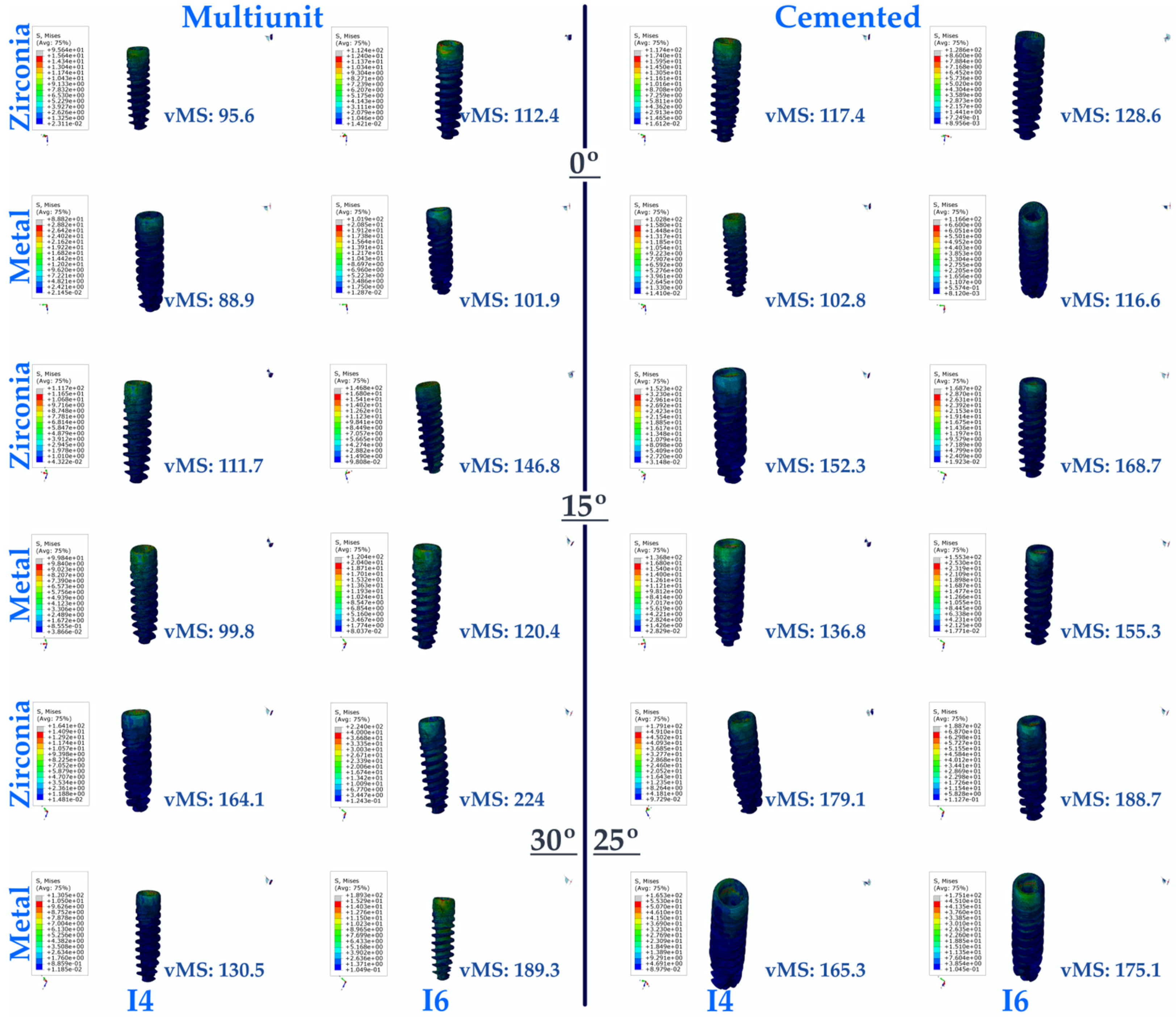
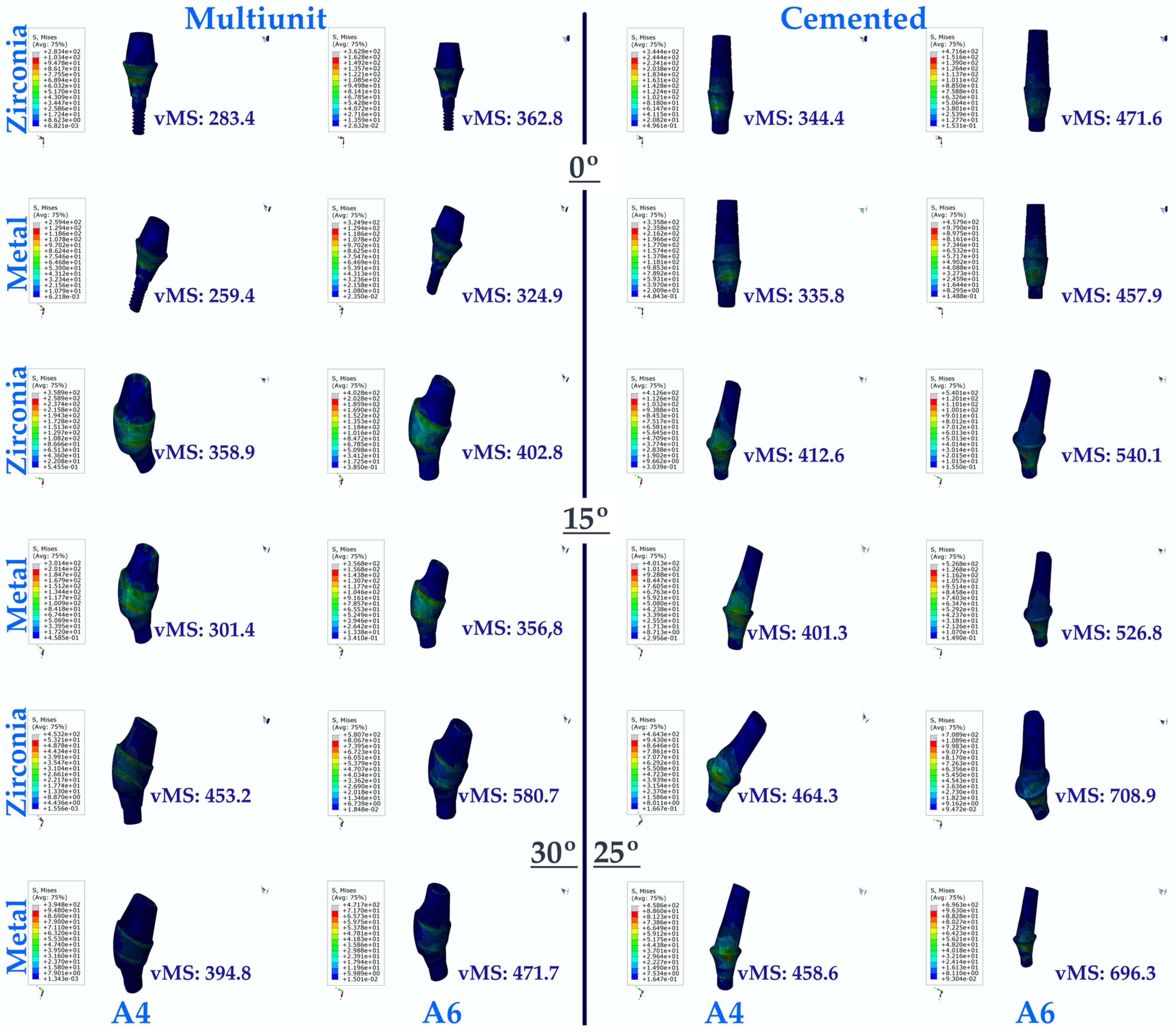
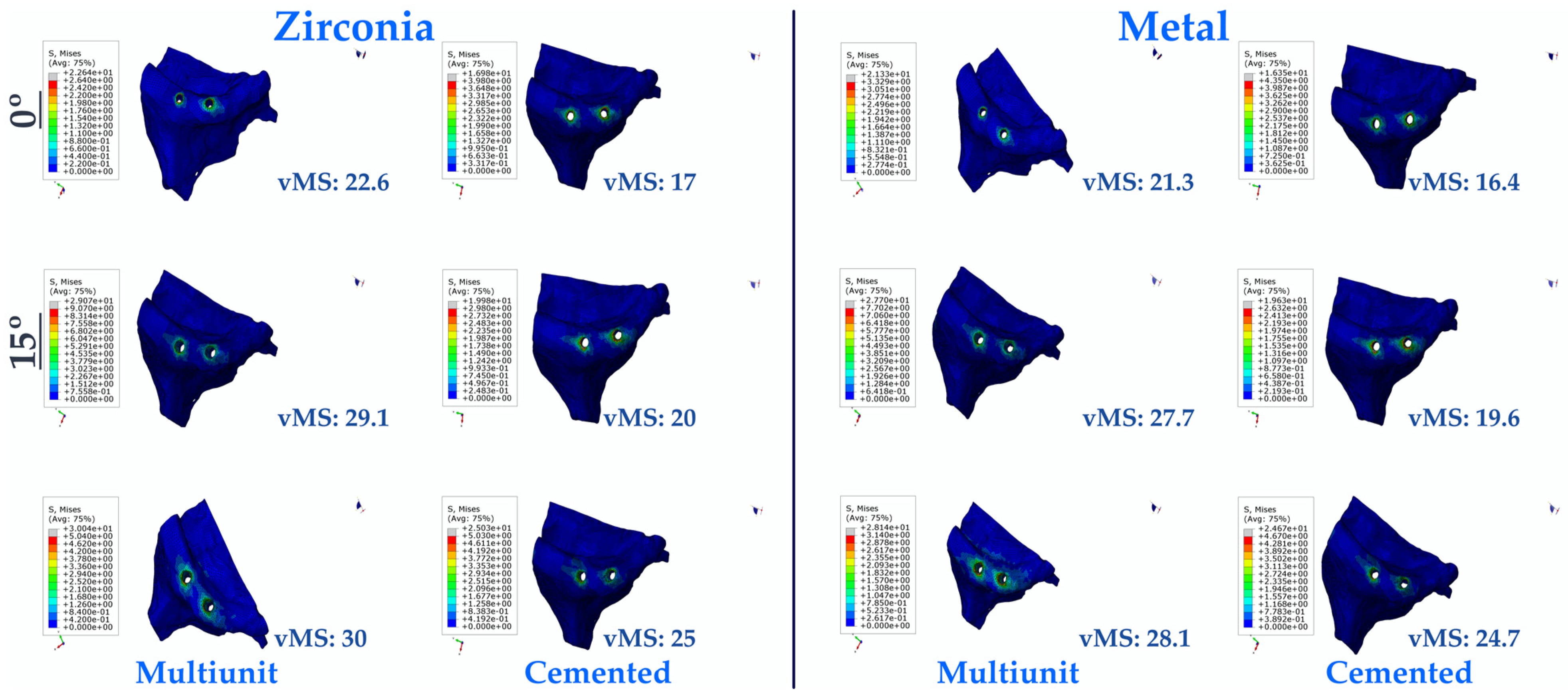
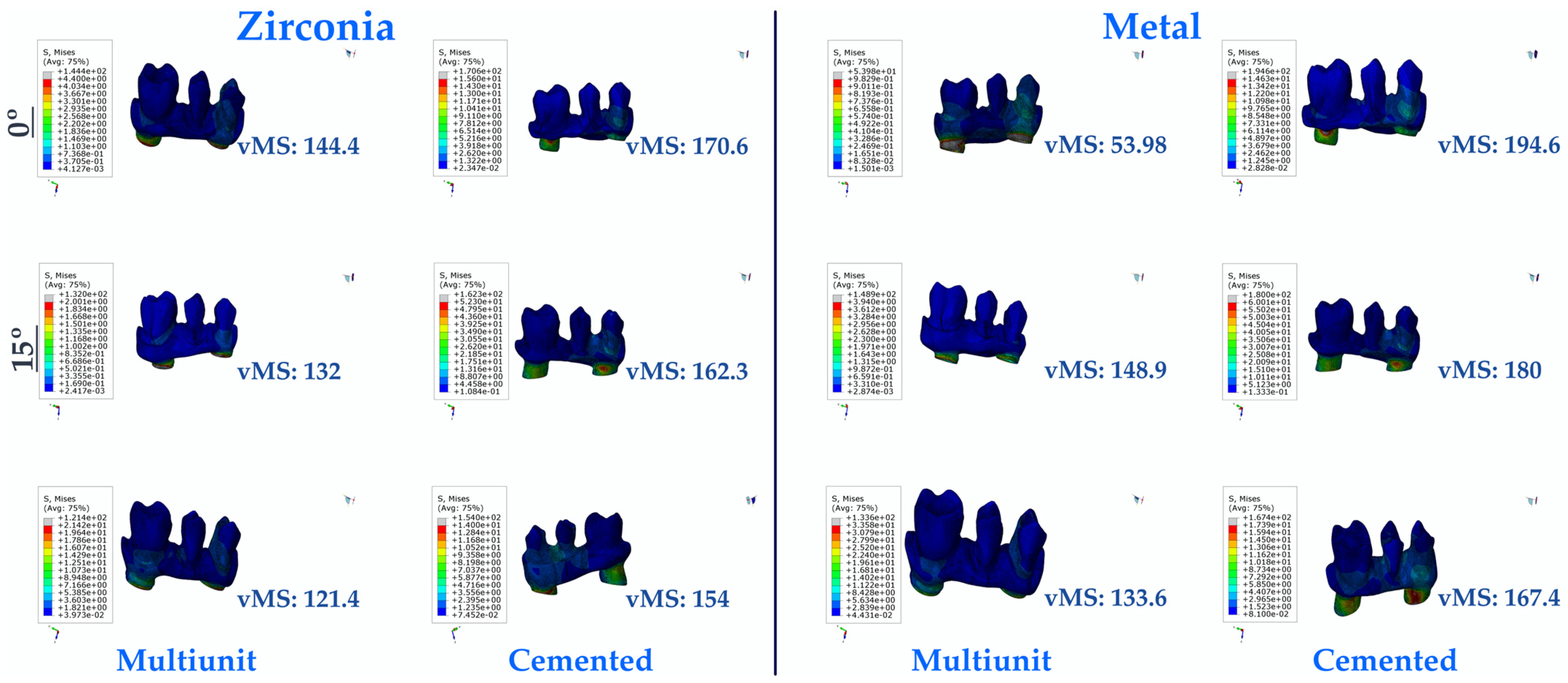
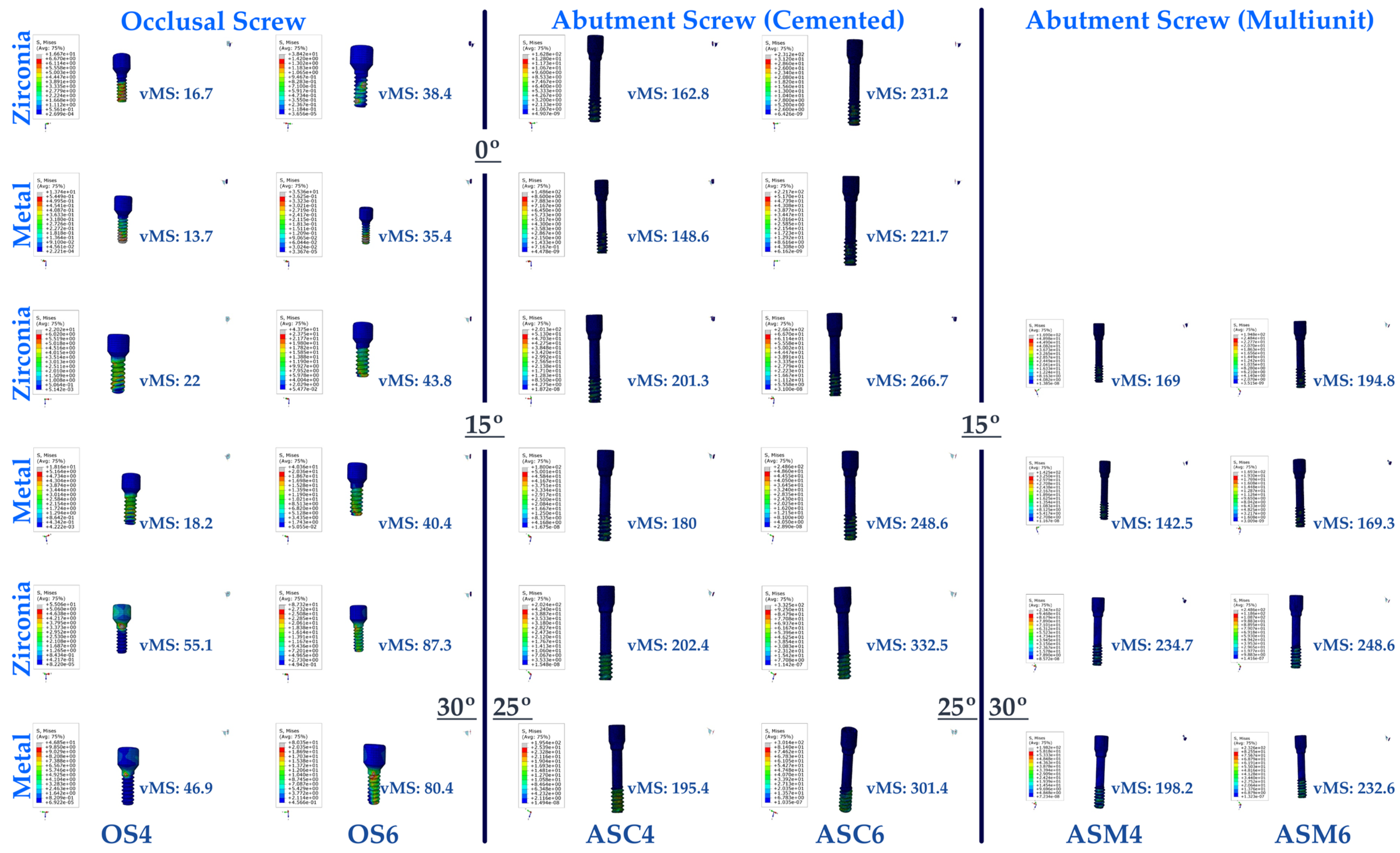
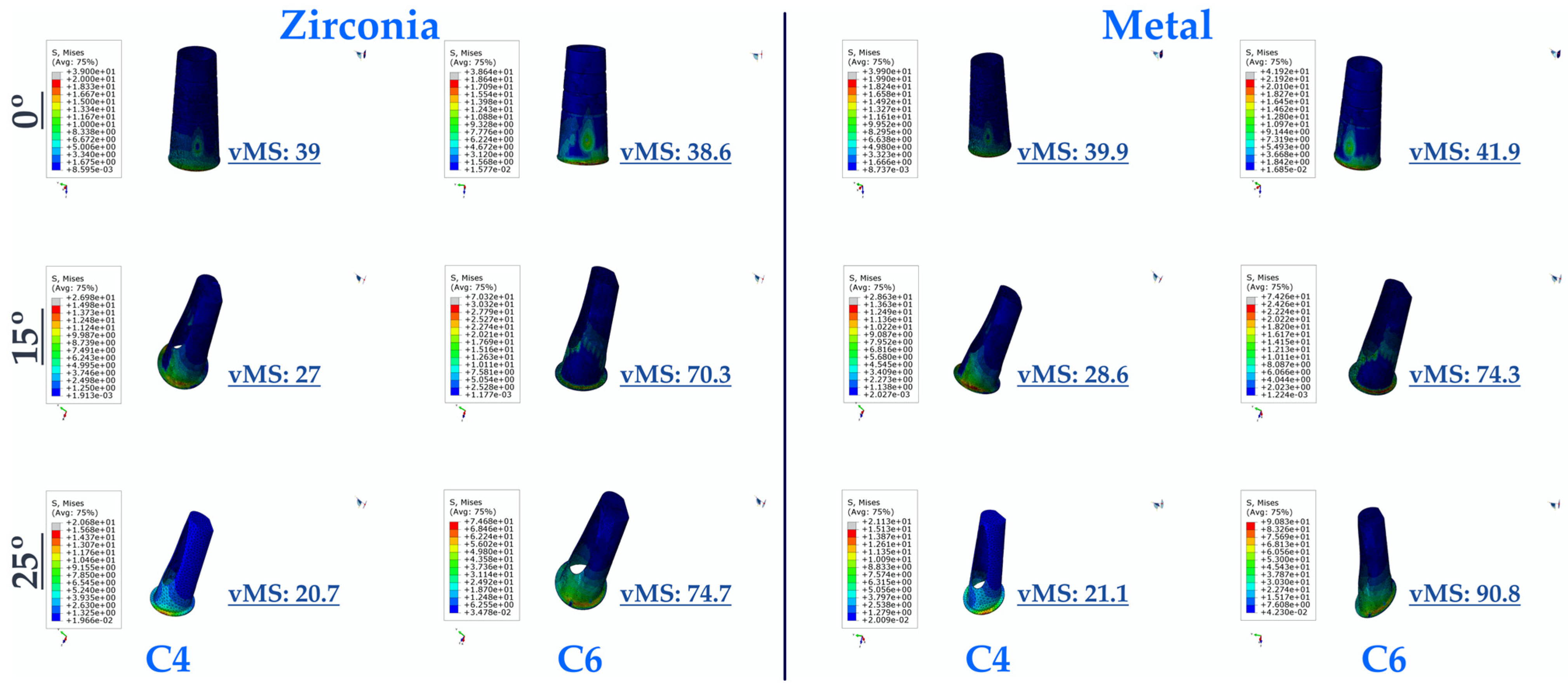
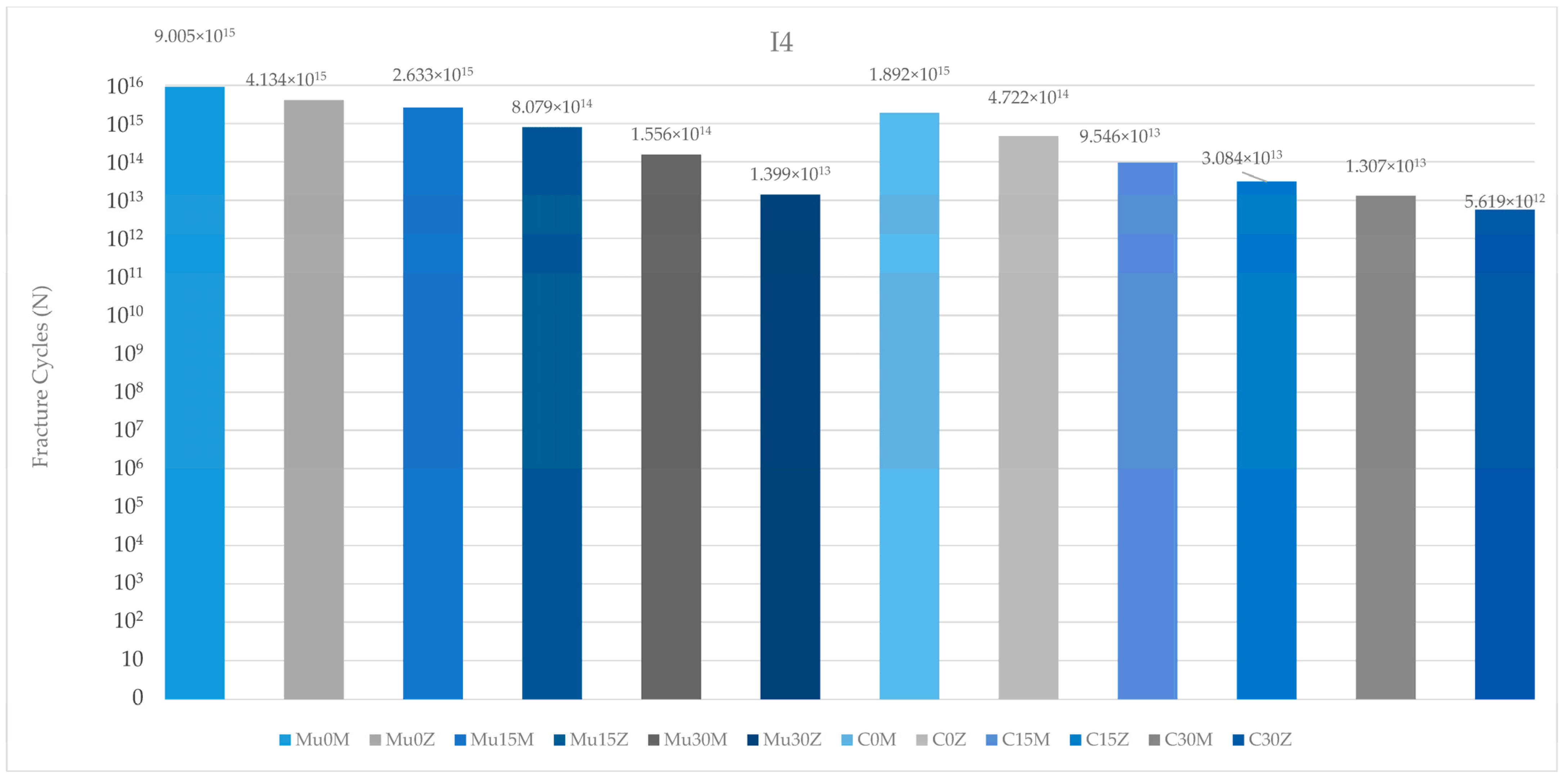
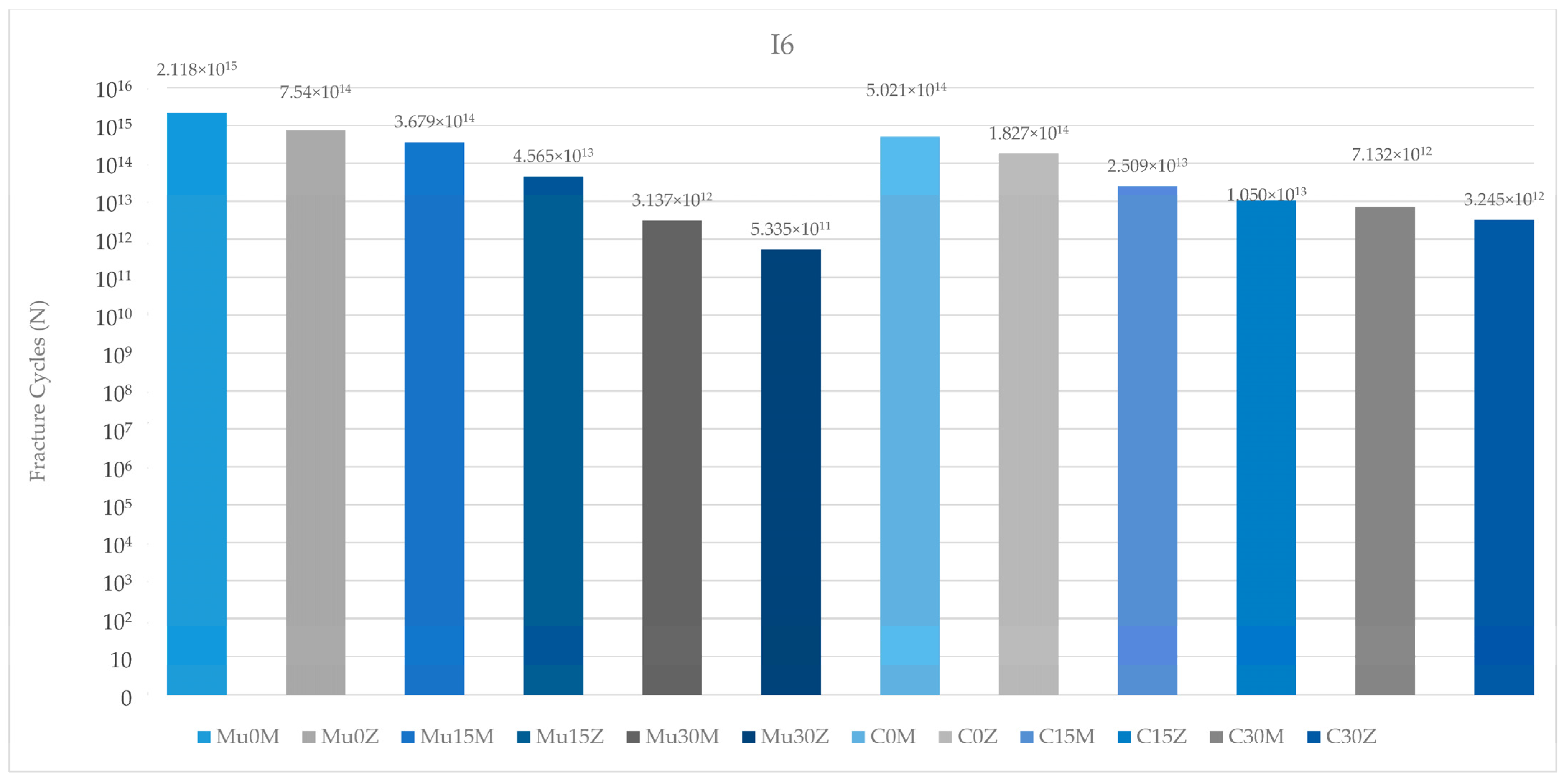
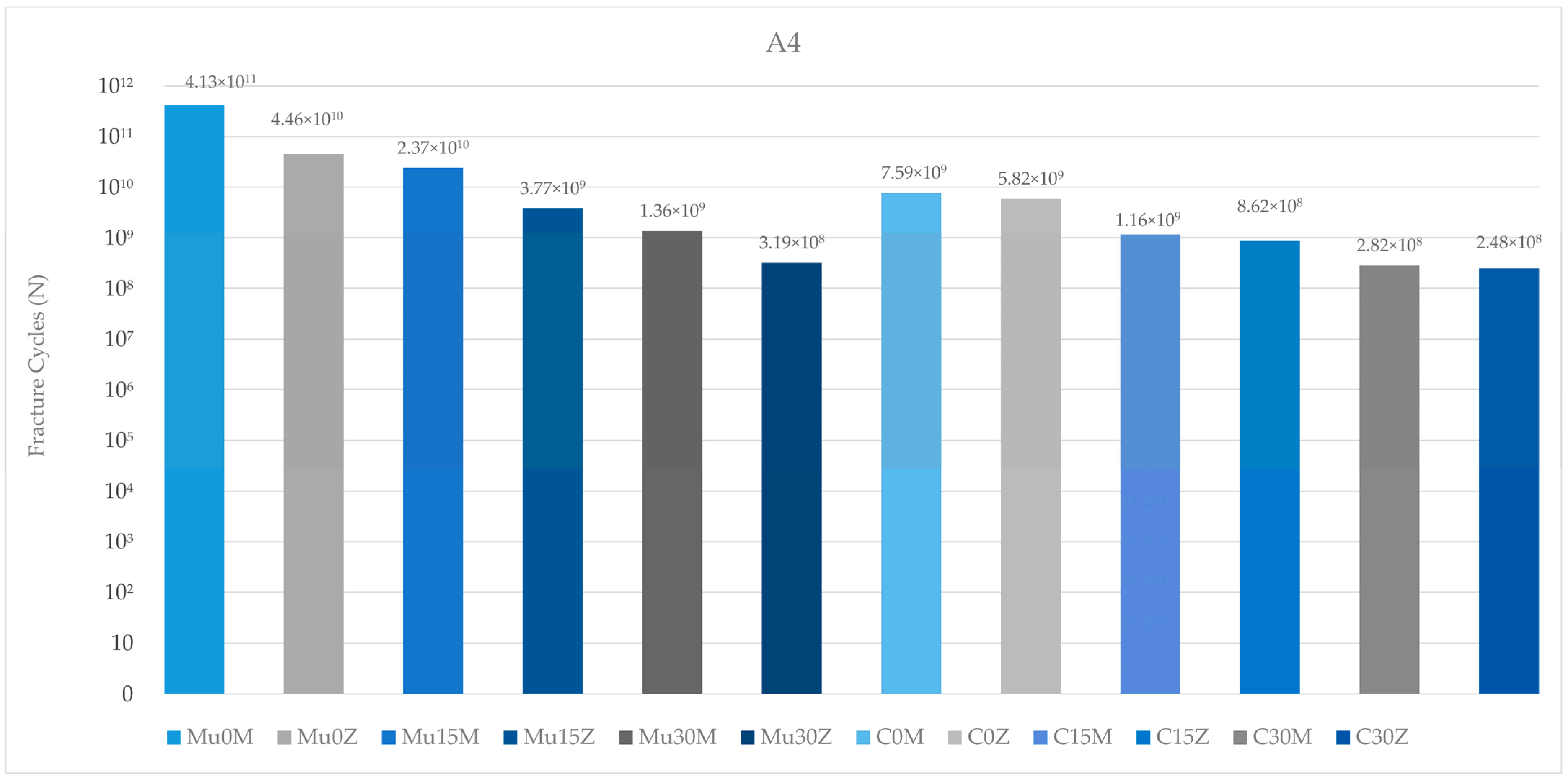
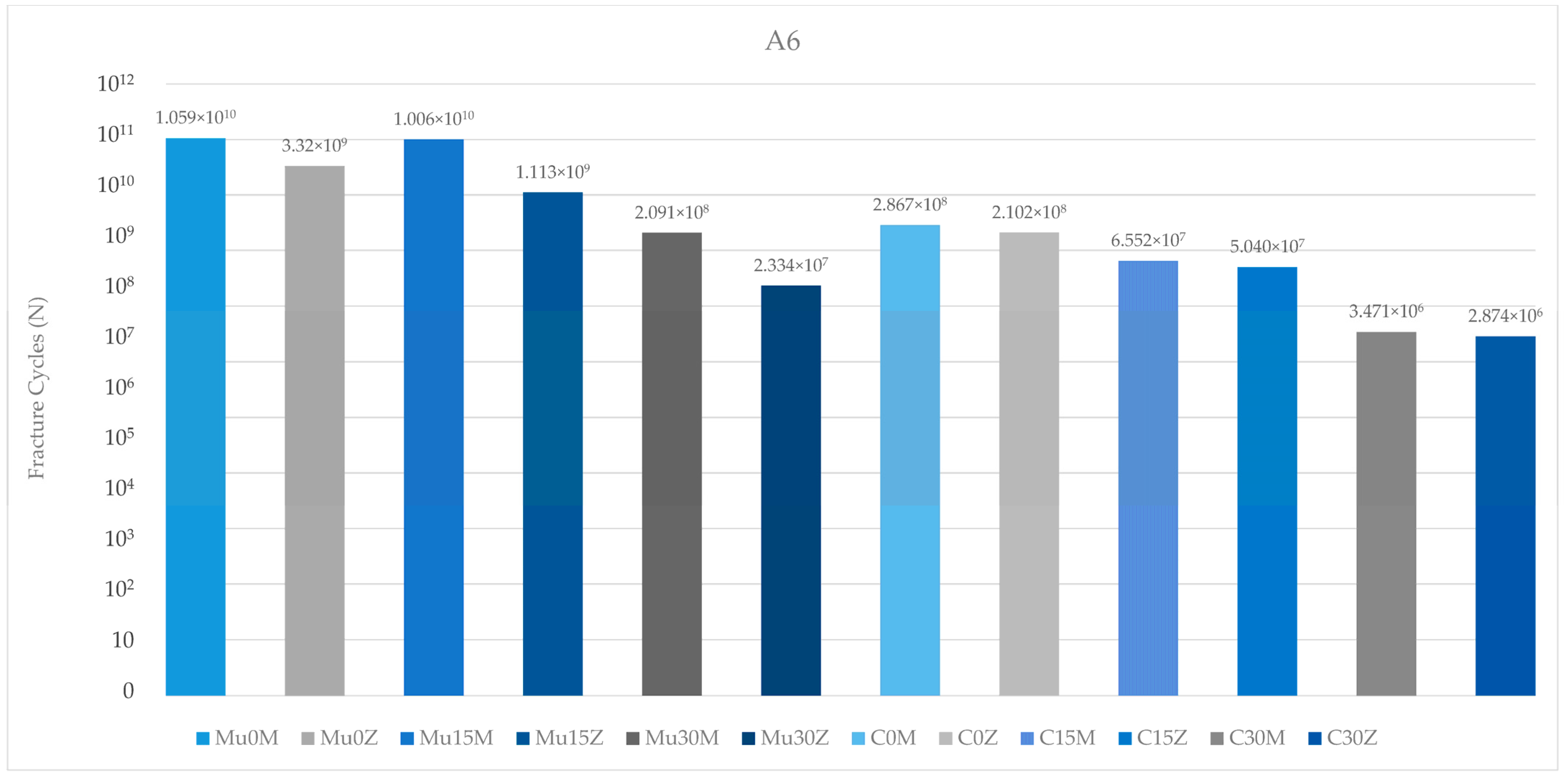
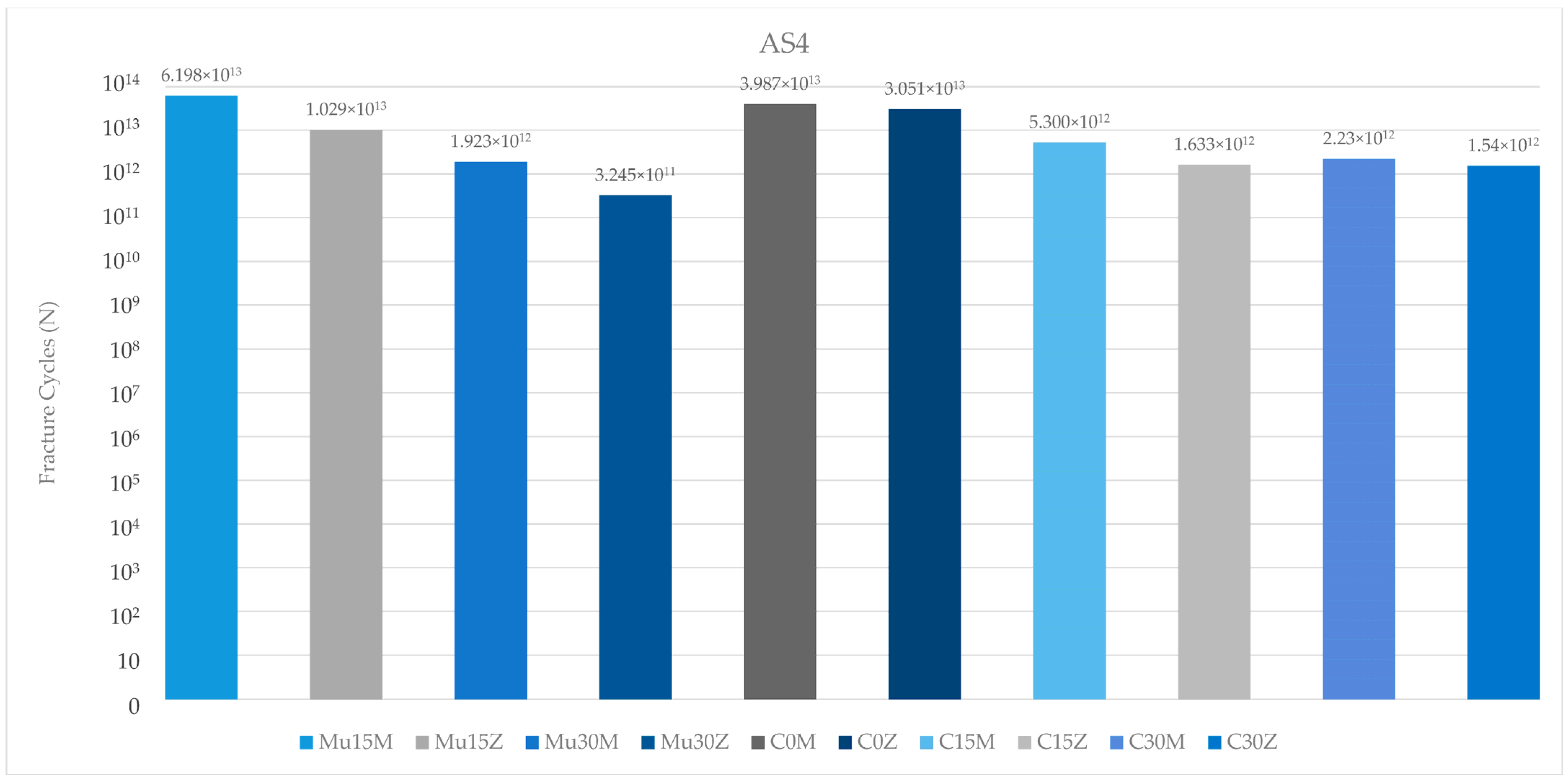
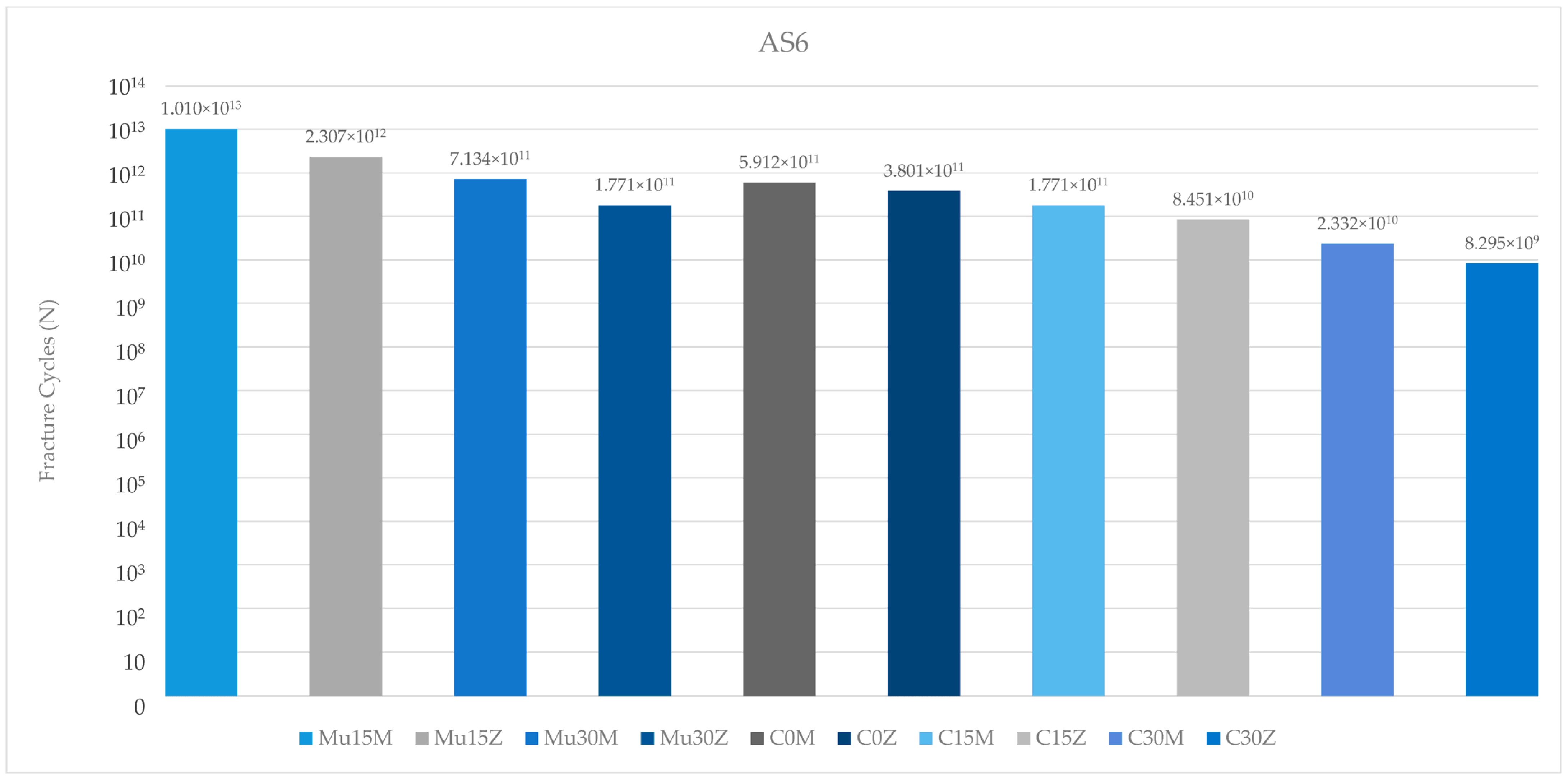
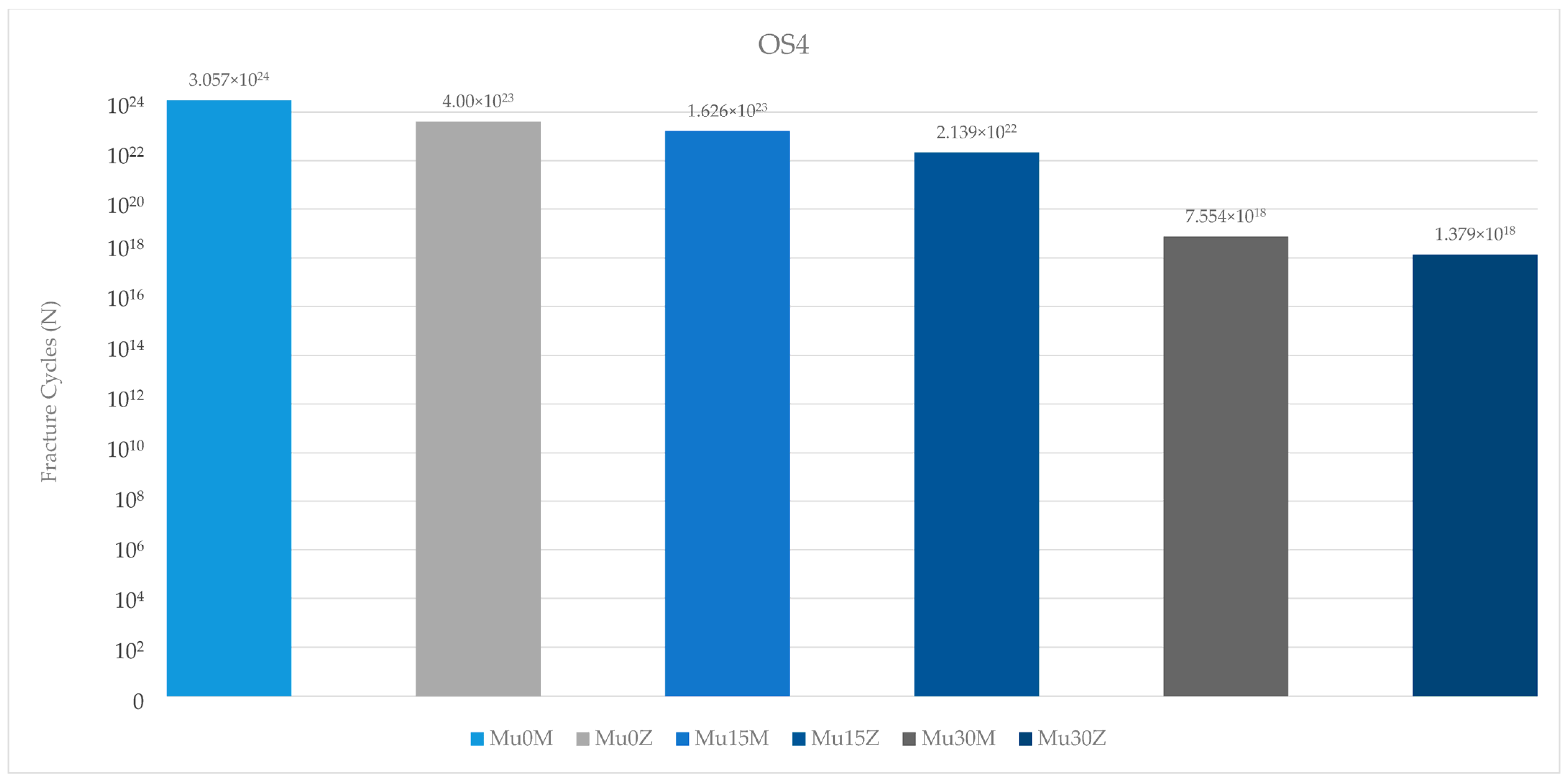
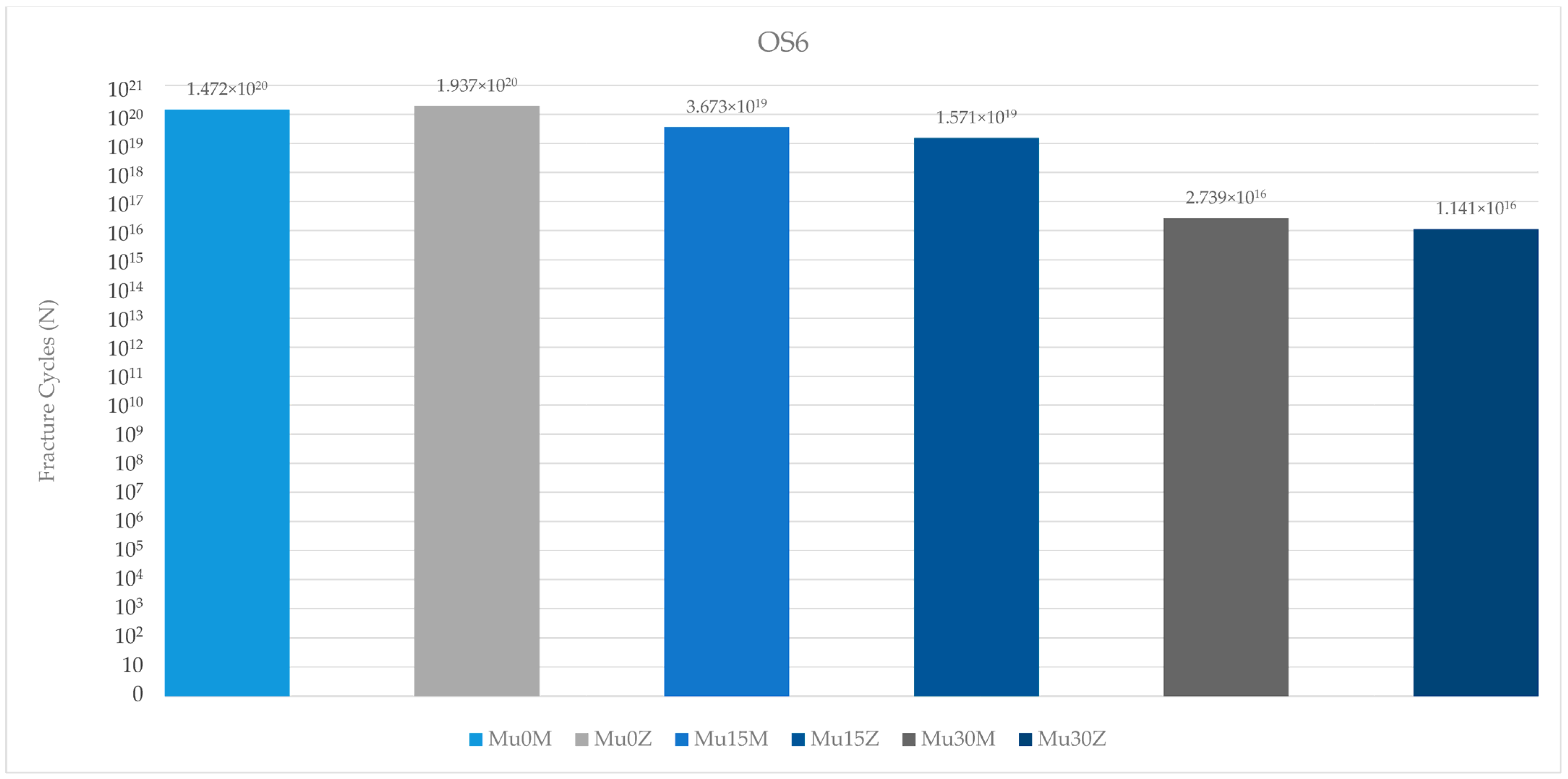
| Model | Total Number of Nodes | Total Number of Elements | Mesh Types |
|---|---|---|---|
| C0 | 2,884,871 | 15,083,472 | Linear tetrahedral elements of type C3D4 |
| C15 | 2,378,953 | 12,324,461 | Linear tetrahedral elements of type C3D4 |
| C25 | 2,032,783 | 10,586,603 | Linear tetrahedral elements of type C3D4 |
| Mu0 | 1,964,012 | 10,388,715 | Linear tetrahedral elements of type C3D4 |
| Mu15 | 2,301,340 | 12,108,325 | Linear tetrahedral elements of type C3D4 |
| Mu30 | 2,516,898 | 13,482,386 | Linear tetrahedral elements of type C3D4 |
| Material | Young’s Modulus (E MPa) | Poisson’s Ratio (ν) | Shear Modulus (G Mpa) | References |
|---|---|---|---|---|
| Cortical Bone | Ex 12,600 Ey 12,600 Ez 19,400 | νxy 0.300 νyz 0.253 νxz 0.253 νyx 0.300 νzy 0.390 νzx 0.390 | Gxy 4850 Gyz 5700 Gxz 5700 | [46] |
| Trabecular Bone | Ex 1148 Ey 210 Ez 1148 | νxy 0.055 νyz 0.010 νxz 0.322 νyx 0.010 νzy 0.055 νzx 0.322 | Gxy 68 Gyz 68 Gxz 434 | [46] |
| Mucosa | 2.8 | 0.40 | [47] | |
| Titanium | 110,000 | 0.33 | [48] | |
| Felspathic Porcelain | 82,800 | 0.28 | [48] | |
| Zirconia | 210,000 | 0.30 | [49] | |
| Co-Cr Alloy | 218,000 | 0.33 | [47] | |
| Resin Composite | 12,000 | 0.33 | [50] | |
| Resin Cement | 5100 | 0.27 | [50] |
Disclaimer/Publisher’s Note: The statements, opinions and data contained in all publications are solely those of the individual author(s) and contributor(s) and not of MDPI and/or the editor(s). MDPI and/or the editor(s) disclaim responsibility for any injury to people or property resulting from any ideas, methods, instructions or products referred to in the content. |
© 2024 by the authors. Published by MDPI on behalf of the Lithuanian University of Health Sciences. Licensee MDPI, Basel, Switzerland. This article is an open access article distributed under the terms and conditions of the Creative Commons Attribution (CC BY) license (https://creativecommons.org/licenses/by/4.0/).
Share and Cite
Erdoğdu, M.; Demirel, M.G.; Mohammadi, R.; Güntekin, N.; Ghanbarzadeh Chaleshtori, M. Influence of Framework Material and Abutment Configuration on Fatigue Performance in Dental Implant Systems: A Finite Element Analysis. Medicina 2024, 60, 1463. https://doi.org/10.3390/medicina60091463
Erdoğdu M, Demirel MG, Mohammadi R, Güntekin N, Ghanbarzadeh Chaleshtori M. Influence of Framework Material and Abutment Configuration on Fatigue Performance in Dental Implant Systems: A Finite Element Analysis. Medicina. 2024; 60(9):1463. https://doi.org/10.3390/medicina60091463
Chicago/Turabian StyleErdoğdu, Meryem, Mehmet Gökberkkaan Demirel, Reza Mohammadi, Neslihan Güntekin, and Masoud Ghanbarzadeh Chaleshtori. 2024. "Influence of Framework Material and Abutment Configuration on Fatigue Performance in Dental Implant Systems: A Finite Element Analysis" Medicina 60, no. 9: 1463. https://doi.org/10.3390/medicina60091463
APA StyleErdoğdu, M., Demirel, M. G., Mohammadi, R., Güntekin, N., & Ghanbarzadeh Chaleshtori, M. (2024). Influence of Framework Material and Abutment Configuration on Fatigue Performance in Dental Implant Systems: A Finite Element Analysis. Medicina, 60(9), 1463. https://doi.org/10.3390/medicina60091463







